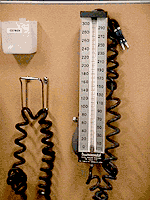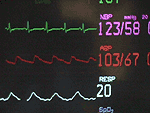Blood Pressure Measurement
What is blood pressure?
Blood pressure is the force that the circulating blood exerts on the walls of the arteries.
Why is blood pressure measured?
It helps the ICU staff monitor the heart and blood flow in the body.
What is a normal blood pressure reading?
Blood pressure varies with age, sex, size and condition of the individual. Normal blood pressure levels vary but a normal reading is approximately 120/60, referred to as "120 over 60". The first or top number is the systolic pressure. This is the pressure generated during contraction of the heart. The second or bottom number is the diastolic pressure. This is the pressure in the arteries when the heart is in the relaxation phase. A critically ill or injured patient's blood pressure may vary greatly, depending upon the patient's condition and current course of therapy. High blood pressure (hypertension) is consistently elevated blood pressure exceeding 140 over 90. Systolic pressure is considered abnormally elevated if consistently over 150. Diastolic pressure is considered abnormally elevated if consistently over 90.
What happens when the blood pressure level is too low or too high?
Depending upon the patient, extreme changes in the level of blood pressure may be harmful. If the level is low, the patient's body and organs may not receive enough blood flow and oxygen. If a low level of blood pressure cannot be corrected, the patient's body functions and organs including the brain, heart, kidneys, and liver, may be at risk to fail. If the level is high, the patient's body and organs may be exposed to high pressures that cause damage leading, if uncorrected, to organ failure.
How is blood pressure measured?
The blood pressure device, a sphygmomanometer, is one of the most commonly used instruments in the ICU. It consists of an inflatable cuff attached to two small tubes that run to the readout or display portion of the device. The cuff is wrapped around the patient's upper arm. The cuff is inflated, then gradually deflates. It senses blood flow and pressure while the heart muscle is both contracting and relaxing. This information is transferred via the tubing to the readout portion of the device.
Does use of a blood pressure device hurt?
No, but the patient can feel the device inflating and deflating.
Can blood pressure be measured another way?
Yes, when the blood pressure is lower or higher than desired, many physicians choose to use a more accurate method of measuring blood pressure, called an intra-arterial blood pressure monitor. In this case, a small tube (catheter) is inserted directly into an artery, usually in the wrist, groin, armpit, or foot. The catheter is connected to the monitor. Blood pressure is continuously displayed on the monitor.
How long is an intra-arterial blood pressure monitor used?
The intra-arterial blood pressure monitor is normally used only for a short time.
Does intra-arterial blood pressure monitoring hurt?
Yes, when the catheter is first inserted the patient experiences discomfort similar to that felt when blood is drawn for testing. However, the discomfort soon goes away.
Are there any potential complications associated with blood pressure measurement or monitoring?
There are no significant complications associated with monitoring blood pressure by the inflatable cuff method. Bleeding and infections are rare complications associated with intra-arterial blood pressure monitoring.
A common type of blood pressure device

Arterial blood pressure (ABP - 103/67) displayed on a bedside monitor
